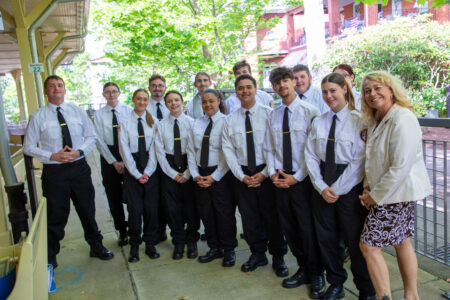Cattaraugus Ambulance Service Honors Illig Family
CATTARAUGUS – In mid-August, a quiet, but heartfelt observance took place at the nearly completed Cattaraugus Ambulance Service Headquarters on South Main Street.
Its purpose, according to Cattaraugus Ambulance EMS Squad Chief Ken Charles: “We wanted to thank John Illig and his mother, Marian (Mrs. Charles Illig) for their generous consideration in offering the former Illig’s Chevrolet-Pontiac, Inc., to us at a price we could manage.”
Before its reincarnation as an ambulance station, the Illig Building spent its years as an automotive garage and showroom. The original structure was built in 1949 by Joe Hartley, who sold it a year later to Clement Chevrolet, owned by Harvey Clement. In 1952, the building again changed hands when Charles (Chuck) Illig and his wife Marian, purchased it and started their own General Motors-affiliated car dealership and garage.
“Illig’s,” as it was known locally, played an important part in the Cattaraugus business community for the next 56 years. When Charles retired in 1978, his son, John, stepped up and ran the company. The car dealership and its service department served its customers and its village well.
But in 2008 GM declared bankruptcy. This led to complicated restructuring tactics that eventually shuttered more than 2,000 dealerships across the United States. Small-town enterprises like Illig’s, although vital to the local economy, were among the first to go. Unable to obtain autos to sell, Illig laid off his workers and closed the doors. For a few years, the building sat idle. Cracks zigzagged across the blacktop. Dandelions and quack grass poked through.
About that same time, the ambulance service was growing ever busier, and feeling the pinch of overcrowding at the Cattaraugus Fire Hall. They’d been sharing space there ever since their startup in 1967 (coincidentally, with a brand-new $11,150 Pontiac vehicle.) They began scouting the village for a suitable building or even a construction site.
“After a couple of false starts,” said Bruce Moody, ambulance board of directors member, “we realized the ideal spot existed right under our noses on South Main Street. We pretty much figured it would be beyond our means, but it wouldn’t hurt to ask. So the Board authorized me to undertake negotiations with John (Illig).”
Illig admits he was shocked at the death of the family business.
“Closing the garage was hard,” he said. “It hurt my mother, too. After all, it was a big part of her life for many years. But, I’ve known for a while now, that it was exactly where our ambulance should be stationed someday. One way or another, I wanted them in there,” he went on, “and I’m grateful we could make it happen.”
Moody was gratified by Illig’s receptiveness to his proposition, and the two men quickly realized they both sought the same outcome. After a couple of offers and counter-offers, they struck a deal agreeable to both parties, and the rest, as they say, is history (or will be, in fifty or sixty years).
Members of the ambulance service excitedly started planning how to adapt their old building to its new purpose. The board met to discuss how they might properly acknowledge the Illigs’ role in their good fortune. According to Charles, it was Moody, once again, who came up with the solution.
“He said he had an idea and he’d take care of it,” said Charles.
A few days later, Moody returned from a visit to Jamestown Bronze Works, Inc. bearing two plaque designs for the board’s scrutiny. A decision was reached, and shortly after, the company delivered a dignified bronze rectangle, which was promptly mounted on the southeast corner of the former garage, proclaiming it formally and forever, “The Illig Building.”
Out of consideration for the elder Mrs. Illig’s frail health, it was decided that the actual dedication ceremony should be a relaxed event, and casual enough that it could be pulled together within 20 to 30 minutes of Mrs. Illig’s decision that she felt up to attending. In fact, when the day arrived, the turnout closely resembled the crew’s typical response to the emergencies that regularly confront them.
On a fine, sunny morning, Mrs. Illig declared herself unusually fit. John called Chief Charles, and within minutes, Illig, his mother, and several ambulance crew members were wheeling into the Ambulance Hall’s parking lot. The little ceremony was quickly accomplished, with handshakes and good wishes all around.
Actually, mounting the plaque was one of the final steps in completing the exterior of the new hall. The time-worn, slightly oil-stained shop has been transformed into a spotless, multi-purpose home base for the ambulance and its keepers. The former auto-repair bays now offer ample room for the ambulance itself, as well as whatever equipment currently needs cleaning, repairing, or storing.
The rest of the interior has been redesigned to better serve its new role. There’s a well-equipped classroom, as well as a training room (for demonstrating and practicing procedures like CPR, splinting, etc.). There’s a dedicated radio room and a well-appointed office for completing the never-ending record keeping and related paperwork that dogs all medical service providers. There are handicapped-accessible restrooms, as well as locker/shower rooms. Service members are justifiably proud of these improvements, feeling they greatly enhance both efficiency and morale within the service.
In addition, Charles pointed out that the roomy new headquarters will allow ambulance personnel to offer some new and innovative services to their community.
“To start with, he said, “we’ll be hosting the annual flu clinic right here on Thursday, Nov. 13. And plans are in the works to hold first aid and heart saver courses for residents, including family health care providers. We want to be as responsive as possible to people’s needs.”
On behalf of the directors, Mr. Moody stated, “There’s plenty here for the community to be proud of.” He went on to praise the service members, both individually and collectively. “I hope people understand what a super group they have here – EMTs and drivers, the whole lot of them, are dedicated people. Some have served for many, many years. Take Roger Erhart. Almost every day, he comes in – looks around – spots something that needs doing – and just does it. I don’t know how we’d get along without him.”
Roger’s wife, Cindy laughed, saying, “We both intended to retire. We even tried it once or twice. But here we still are.”






